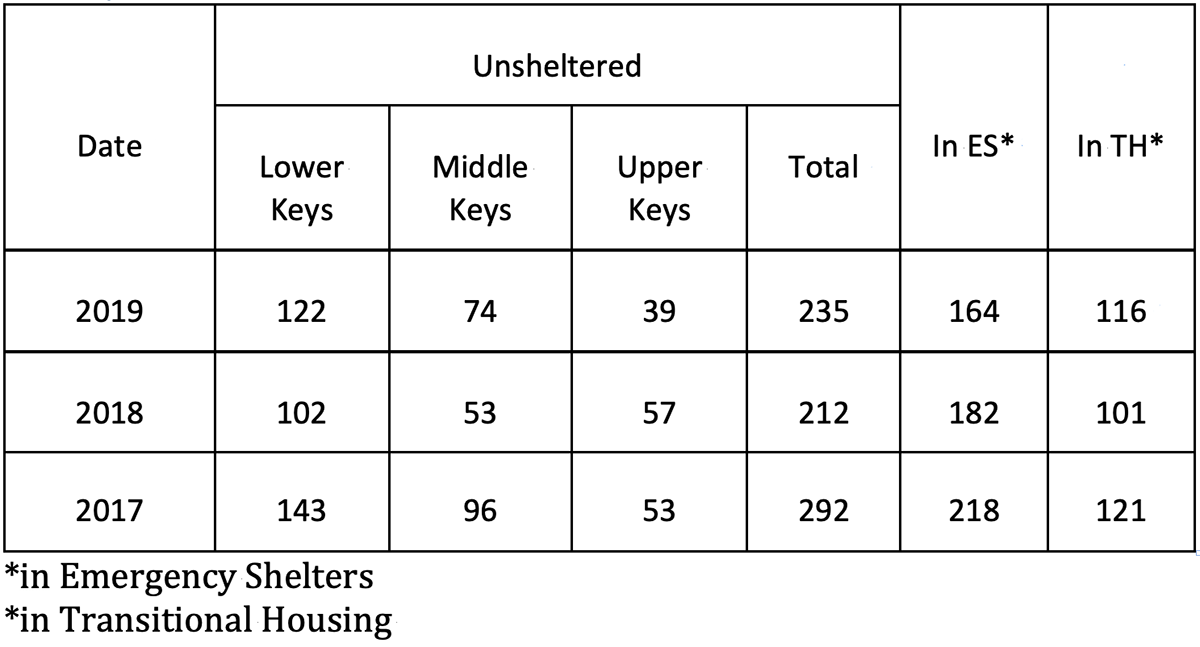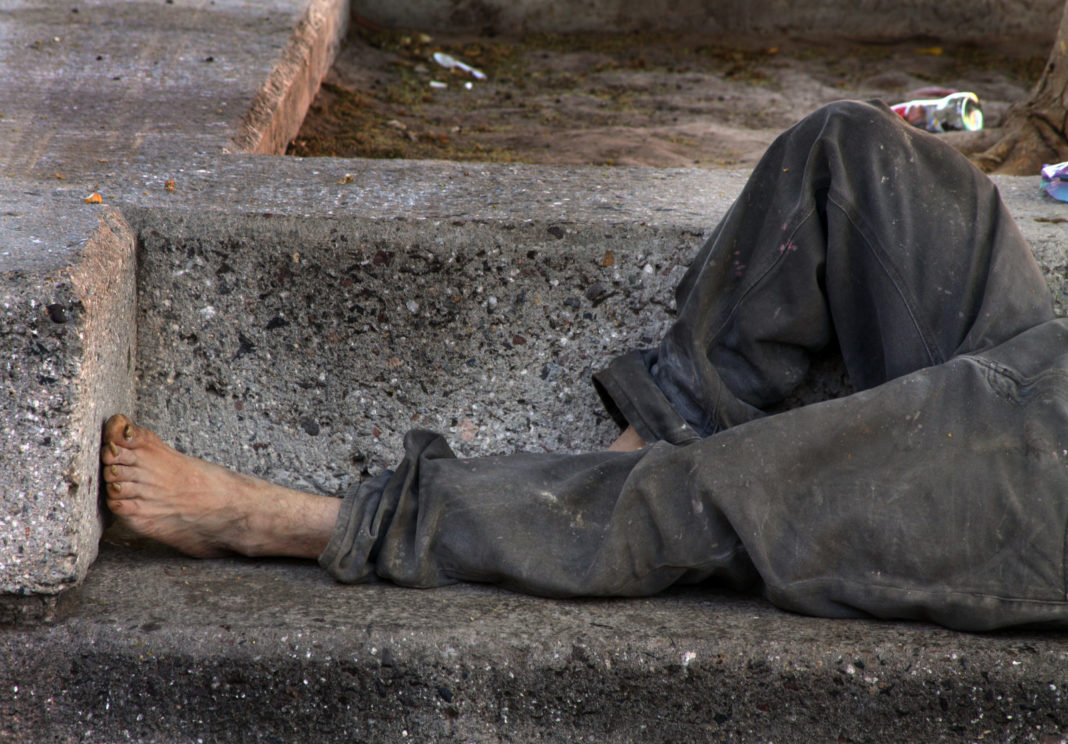Paradise has its problems, and homelessness in the Keys is one of them. While some transient people seek out the Keys’ warm weather, many of Monroe County’s homeless have lived here for years. Perhaps they lost a job, fell back on rent, are escaping domestic violence or struggling with addiction. Essentially: many the homeless people we see in the Keys were our neighbors a few months or years ago.
The Monroe County Continuum of Care (CoC), the lead agency for homeless services in the Florida Keys, just released its annual “point in time” census of the homeless population.
“This count is mandated by HUD and gives us a snapshot of the homeless population at a given time,” said CoC’s executive director, Mark Lenker. (See graphic).
“The cold weather, and the choppy water which prohibited the Upper Keys from surveying boats, may have made the Upper Keys count artificially low,” Lenker noted.
As of Jan. 29, the CoC also had 164 clients in emergency shelters and 116 in transitional housing, for a total count of 515 homeless in Monroe County.This is higher than in 2018 but lower than 2017.
“We know that Hurricane Irma likely depressed the 2018 count as some homeless took shelter in Miami and did not return,” said Lenker.
These numbers aren’t high, considering the population of the Florida Keys is about 73,000. That means we are doing something right in keeping our population housed — and that hasn’t always been the case.
“There have basically always been homeless people in the Keys, and the culture was probably less compassionate in the ’60s and ’70s,” said Commissioner Sam Kaufman, who is chairman of the board of the Florida Keys Outreach Coalition (FKOC). “I came in the late ’90s, at a time when there was a significant issue.” Kaufman, who as a public defender in Miami was part of what the Miami Herald billed as “the dream team for the homeless,” noted that in the early 2000s, the Bridle Path on Smathers Beach was essentially a tent city. “There were people sleeping on Duval Street in much larger numbers too,” he said.
That’s when Keys Overnight Temporary Shelter (KOTS) was constructed, and over the years, organizations and individuals have made a concerted effort to house the Keys’ homeless. Two women who have been a huge part of that effort are Elicia Pintabona, executive director of the Southernmost Homeless Assistance League (SHAL) and Stephanie Kaple, executive director of the Florida Keys Outreach Coalition (FKOC).
SHAL has a contract with the city to run KOTS, which houses between 108 and 120 homeless clients any given night, and is again up for movement to a new location in September 2019. While KOTS was intended to be temporary, emergency shelters are necessary, even if the Keys don’t have a huge homeless population.
“Point in time data has shown us that there is a homelessness problem throughout Monroe County,” Pintabona said, “and the issue with those that are anywhere other than the Lower Keys is that they are unsheltered. Our partners in Marathon and the Upper Keys do a great job, but shelter is not as readily available.”
KOTS doesn’t just provide shelter, either. “We try to get them linked with benefits,” Pintabona said, “like food stamps, a cell phone, employment services, a work uniform, transitional housing opportunities like FKOC, and basic things like getting them a local ID which is now $8.75.”
Transitional housing — moving clients from an emergency shelter like KOTS into a apartment or dorm-like housing with an eye for independence — is FKOC’s territory.
“We provide steps to permanent housing,” said FKOC’s Stephanie Kaple. “We have emergency temporary 90 day housing with very strict rules; then we have transitional housing with fewer roommates and kitchen access; when we move to a third phase, you can just have one roommate, a night job, and we give you opportunities to make mistakes in a safe environment.”
So if these organizations are doing such good in the communities, what’s the problem?
One is that all of FKOC’s 172 beds are also in Key West, meaning many homeless in the Middle and Upper Keys find unconventional shelter in places like the mangroves. Marathon does have Keys Area Interdenominational Resources (KAIR), which provides social services, and Independence Cay, offering a dozen beds for men, but there are not close to the resources available in Key West.
The second concern is that the county has been pressing the city to move KOTS for 15 years. It is on county property at the Sheriff’s Department, which has voiced complaints, and neighboring Sunset Marina condo owners filed a lawsuit with the city for KOTS being next door to their gated community. While KOTS is cheaper for taxpayers — a night at KOTS is under $10 while it’s more than $100 at the jail — there are still occasional issues with clients on the sheriff’s property, a case in point being last week with a man stealing the sheriff’s office’s American flag.
“The problem is,” Sheriff Rick Ramsay said, “nobody wants a homeless shelter close to their business, close to their home, close to their kids.”
“You get a lot of NIMBY,” said Pontabina, “which is ‘not in my backyard.’”
The city had agreed to move KOTS to the property where Easter Seals once was on College Road, but affordable housing took precedence. “At least everyone is trying to be part of the solution, and it’s hopeful, but the city thinks KOTS should stay, and that’s been the response for 15 years,” he said. Ramsay said he thought the Easter Seals property was a “good solution” for the new KOTS location but acknowledged that “they want to do affordable housing because it’s more of a crisis need.”
Affordable housing is a crisis need — and it dovetails with the homelessness problem. Kaple highlights the problem of wages not matching cost of living in the Keys.
“A lot of people presume that the people in the shelter are unemployed,” she said, “But most clients have a full-time job if not a second or third part-time position. They are underemployed.” Getting homeless people into jobs that can sustainably allow them to pay rent — not to mention childcare — in the Keys is a huge feat. The organizations that feed into the CoC also compete with each other for grants.
Pintabona said, “Part of the problem is that right now, it’s a well-maintained issue. If it was a huge problem, it would have a huge will. But this problem actually needs support desperately.”

Read Part 2 of Homeless in Paradise next week.
For more info read: STRUGGLING TO SURVIVE



















